

Assessment: The dental implant process begins with a thorough assessment. The patient's oral health, bone structure, and overall health condition are evaluated through clinical examination and digital imaging (X-rays, CT scans). Discussion: The dentist discusses the patient's expectations, explaining the benefits and potential risks of dental implants. The suitability of dental implants as the best treatment option is evaluated, considering factors like bone density and gum health.
Treatment Plan: A personalized treatment plan is created, detailing the steps involved, the timeline, and the costs. If necessary, pre-implant procedures like bone grafting are discussed.
Bone Grafting: If the patient has insufficient bone mass to support an implant, bone grafting might be recommended. This involves augmenting the bone in the jaw to provide a stable foundation for the implant. Sinus Lift: In cases where the upper jaw lacks sufficient bone height or the sinuses are too close to the jaw, a sinus lift may be performed to create space for the implant.
Anesthesia: Local anesthesia or sedation is administered to ensure comfort during the procedure. Implant Insertion: The dentist surgically inserts the titanium implant into the jawbone. This implant acts as an artificial tooth root. The procedure is performed with precision to ensure the implant is positioned correctly. Healing Period: After placement, the implant is left to heal and integrate with the bone in a process called osseointegration, which typically takes 3-6 months. During this time, a temporary crown or denture may be provided to maintain aesthetics.
Second Surgery: Once osseointegration is complete, a minor surgery is performed to attach an abutment to the implant. This abutment serves as a connector between the implant and the final restoration
Healing: The gum around the abutment is allowed to heal for a few weeks, ensuring that the area is ready for the final prosthesis.
Crown Fabrication: Impressions of the patient's mouth are taken to create a custom crown that matches the natural teeth in shape, size, and color.
Crown Placement: The custom-made crown is securely attached to the abutment, completing the restoration. The dentist ensures that the crown fits perfectly, functions properly, and looks natural.
Adjustment: Minor adjustments may be made to ensure a perfect bite and comfort.
Instructions: Patients receive detailed post-operative care instructions, including oral hygiene practices, dietary recommendations, and activity restrictions.
Follow-Up Visits: Regular follow-up visits are scheduled to monitor the implant's integration, gum health, and overall success of the treatment.
Regular Check-Ups: Patients are encouraged to visit the clinic for periodic check-ups to ensure the implant remains healthy and functional.
Professional Cleaning: Routine professional cleanings help maintain the health of the implant and surrounding tissues.
Patient Education: Ongoing education on maintaining optimal oral hygiene is provided to ensure the longevity of the implant.
At First Care Dental Clinic and Implant Center, the entire dental implant process is designed with patient comfort, precision, and long-term success in mind. Each step is executed with the highest level of care, resulting in a natural, functional, and aesthetically pleasing outcome.


Comprehensive Evaluation: The smile makeover process starts with a detailed consultation where your dental health, facial features, and aesthetic goals are thoroughly assessed. This helps the dentist understand your current smile and identify areas for improvement.
Discussion of Goals: You’ll discuss what aspects of your smile you want to enhance, such as tooth color, alignment, shape, or gaps. This conversation ensures that the treatment plan aligns with your vision.
Treatment Planning: A personalized smile makeover plan is developed, potentially including teeth whitening, veneers, crowns, bonding, orthodontics, or dental implants, depending on your needs.
Pre-Whitening Evaluation: Before any whitening treatment, your teeth are evaluated to ensure suitability, minimizing the risk of sensitivity.
Whitening Procedure: Professional teeth whitening is performed either in-office or with take-home kits, creating a brighter, more youthful smile that can boost confidence.
Assessment: If realignment is needed, orthodontic treatment like braces or clear aligners may be recommended. Treatment: Over several months, these appliances gradually shift your teeth into their ideal position, enhancing both function and aesthetics.
Dental Bonding: Minor imperfections such as chips or gaps can be corrected with dental bonding, where a tooth-colored resin is applied and sculpted.
Veneers: Custom-made veneers cover the front surface of the teeth, perfect for correcting discoloration, uneven spacing, or irregular shapes.
Crowns: Severely damaged or discolored teeth may be restored with crowns, which are designed to match surrounding teeth for a natural look.
Implant Placement: For missing teeth, dental implants may be included. The process involves placing a titanium post into the jawbone, followed by a healing period.
Gum Evaluation: If your gums are uneven or excessive, gum contouring can create a more balanced and symmetrical smile. Procedure: Excess gum tissue is carefully reshaped, improving the appearance of your smile with minimal discomfort.
Fit and Function Check: After completing all procedures, the dentist ensures your bite is correct, and all restorations fit perfectly.
Review of Results: Your new smile is reviewed, making sure it meets your expectations.
Care Instructions: You’ll receive detailed instructions on maintaining your new smile, including brushing, flossing, and any special care tips.
Follow-Up Visits: Regular check-ups are scheduled to monitor your teeth, gums, and restorations, ensuring your smile stays at its best.
Improved Relationships: A beautiful smile can positively impact how others perceive you, leading to stronger personal and professional relationships.
Better First Impressions: A bright, well-aligned smile often creates a positive first impression, which can be crucial in various aspects of life, from job interviews to social gatherings.
Increased Happiness: Feeling good about your appearance can enhance your overall mood and contribute to a more positive outlook on life
At First Care Dental Clinic and Implant Center, a smile makeover not only transforms your appearance but also brings substantial benefits to your personal and professional life, empowering you with renewed confidence and satisfaction.
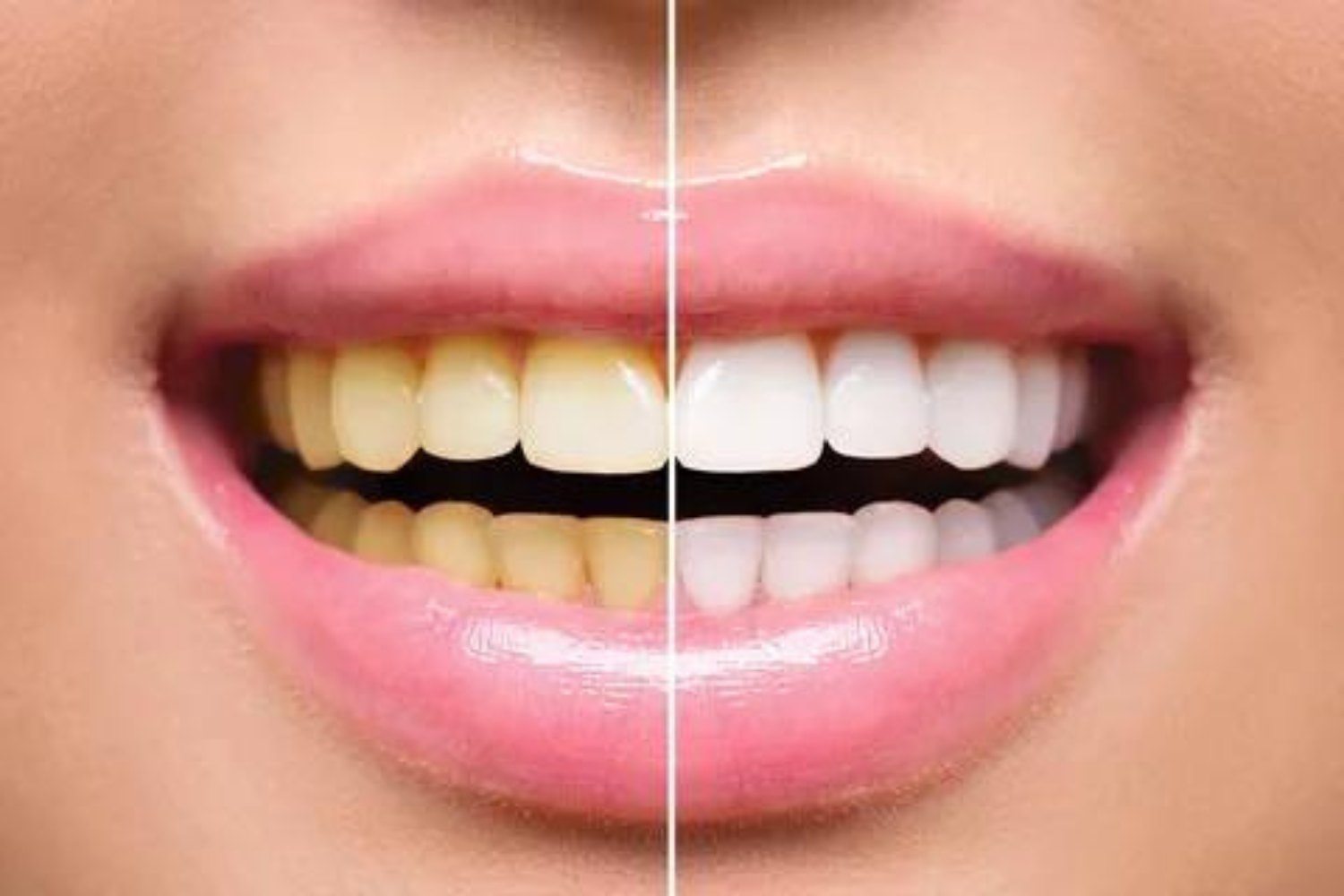

Assessment: The teeth whitening process begins with a thorough examination of your oral health. The dentist evaluates the condition of your teeth and gums to determine if you are a suitable candidate for whitening. This may include checking for cavities, gum disease, or tooth sensitivity, which need to be addressed before whitening.
Discussion: The dentist discusses your goals and expectations for the whitening procedure, including the desired shade of whiteness. This helps in selecting the most appropriate whitening method for your needs.
Cleaning: Before the whitening procedure, your teeth will be professionally cleaned to remove any plaque, tartar, and surface stains. This ensures that the whitening agent can penetrate evenly and effectively.
Shade Selection: The current shade of your teeth is recorded, and the dentist will show you the potential results using a shade guide. This helps in setting realistic expectations for the outcome.
Protection: To begin, your gums and soft tissues are protected using a barrier, ensuring that the whitening gel only contacts your teeth. Application of Whitening Gel: A high-concentration peroxide-based whitening gel is applied to the teeth. This gel breaks down stains and discoloration on the enamel and dentin layers of the teeth.
Activation: Depending on the specific treatment, a special light or laser may be used to activate the whitening gel, accelerating the process. The gel is typically left on the teeth for 15-30 minutes, and the procedure may involve multiple applications in a single session.
Monitoring: Throughout the procedure, the dentist monitors your comfort and the progress of the whitening to ensure optimal results.
Rinsing and Evaluation: After the whitening process is complete, the gel is removed, and your teeth are rinsed. The dentist will evaluate the new shade of your teeth and compare it to the initial shade recorded.
Sensitivity Management: Some patients may experience temporary tooth sensitivity after whitening. The dentist may apply a desensitizing gel or recommend products to help manage sensitivity at home.
Custom Trays: If you opt for or are provided with a take-home whitening kit, custom-fitted trays will be made based on impressions of your teeth. These trays ensure even application of the whitening gel and protect your gums.
Instructions: You will receive detailed instructions on how to use the whitening trays and gel at home. Typically, you will need to wear the trays for a specified amount of time each day for several days or weeks, depending on the desired results.
Follow-Up Visit: A follow-up visit may be scheduled to assess the effectiveness of the whitening treatment and address any concerns. This allows the dentist to check for any sensitivity and ensure your satisfaction with the results.
Maintenance Tips: The dentist provides guidance on how to maintain your newly whitened smile. This includes avoiding foods and drinks that can stain your teeth, such as coffee, tea, and red wine, as well as the importance of good oral hygiene practices.
Touch-Up Treatments: Depending on your lifestyle and oral habits, the dentist may recommend periodic touch-up treatments to maintain the brightness of your smile over time.
Enhanced Appearance: Teeth whitening can significantly improve the appearance of your smile, making it brighter and more youthful.
Boosted Confidence: A whiter smile can increase your confidence in social and professional settings, helping you feel more comfortable when speaking or smiling.
Quick Results: In-office teeth whitening offers immediate results, often lightening teeth by several shades in just one visit.
Customizable Treatment: The process is tailored to your needs, with options for in-office treatments, take-home kits, or a combination of both
At First Care Dental Clinic and Implant Center, the teeth whitening process is designed to be safe, effective, and tailored to your individual needs, helping you achieve a brighter, more confident smile.


Comprehensive Evaluation: The process begins with a thorough assessment of your dental health. The dentist evaluates your teeth, gums, and bite to determine if veneers are the right solution for your aesthetic goals. This includes discussing your dental history and any concerns you may have.
Discussion of Goals: You will discuss what you hope to achieve with veneers, such as correcting discoloration, chips, gaps, or irregularly shaped teeth. This helps in creating a tailored treatment plan.
Custom Treatment Plan: Based on the evaluation and your goals, a personalized treatment plan is developed. The dentist will explain the procedure, costs, and timeline involved in placing veneers.
Shade Selection: The dentist helps you choose the appropriate shade for your veneers, ensuring they match the color of your natural teeth for a seamless look.
Preparation: To make space for the veneers, a small amount of enamel (typically 0.5 mm) is gently removed from the front surface of the teeth being treated. This is done under local anesthesia to ensure comfort.
Impressions: After preparation, precise impressions of your teeth are taken. These impressions are sent to a dental laboratory to create custom veneers that fit perfectly.Placement of Temporary Veneers: While your permanent veneers are being fabricated, temporary veneers may be placed on your teeth. These help protect the prepared teeth and provide an idea of how your final smile will look.
Lab Process: The impressions are used to create custom porcelain or composite resin veneers in a dental lab. This process typically takes about 1-2 weeks.
Quality Check: Once ready, the veneers are checked for quality, fit, and aesthetics before the final placement appointment.
Try-in: During your next visit, the dentist will try the veneers on your teeth to ensure proper fit, color, and shape. Any necessary adjustments are made at this stage.
Bonding Process: After final adjustments, the veneers are bonded to your teeth using a special dental adhesive. The dentist carefully positions each veneer and uses a curing light to harden the adhesive, securing the veneers in place.
Final Check: The dentist checks your bite and makes any final adjustments to ensure comfort and functionality.
Care Instructions: You’ll receive guidance on how to care for your new veneers, including oral hygiene practices and dietary recommendations to maintain their appearance.
Regular Check-Ups: Follow-up visits are scheduled to monitor the condition of the veneers and your overall oral health.
Maintenance Tips: The dentist provides tips on how to maintain the longevity of your veneers, including avoiding excessive force (such as biting hard objects) and regular dental cleanings.
Enhanced Appearance: Veneers can dramatically improve the aesthetics of your smile by correcting a range of imperfections.
Natural Look: High-quality porcelain veneers mimic the appearance of natural teeth, providing a seamless blend with your smile.
Durability: Veneers are resistant to stains and can last many years with proper care.
Boosted Confidence: A beautiful smile can significantly enhance your self-esteem and confidence in social situations.
At First Care Dental Clinic and Implant Center, the dental veneer process is designed to create a customized, beautiful smile that enhances your overall appearance, helping you feel more confident and satisfied with your teeth.

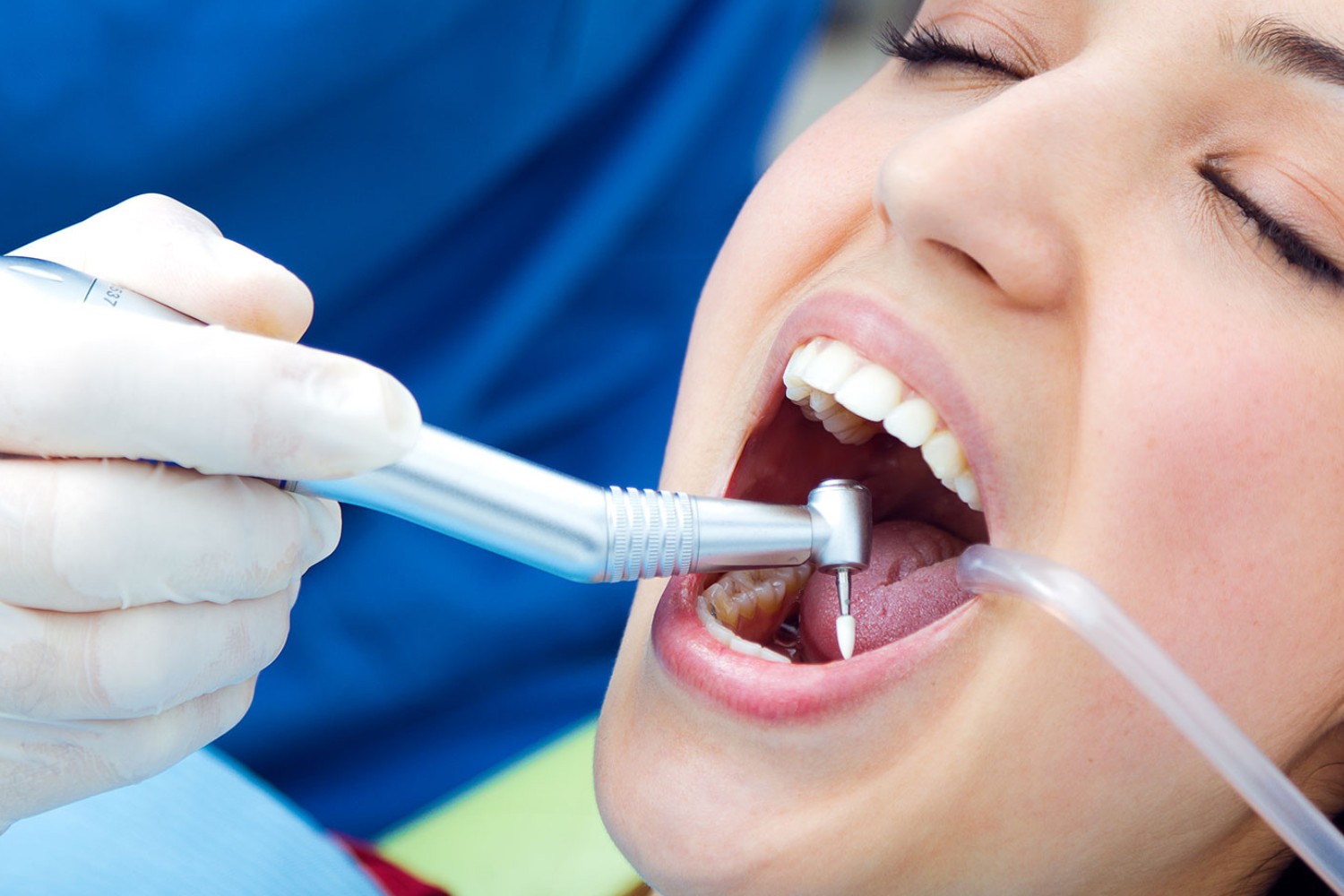
This type of dental restoration procedure is used to repair tooth damage from decay, cavities, fractures, and chipping. Mostly white composite resin (tooth-colored material) that is often offered in a variety of shades of white to match the natural color of your teeth. Regardless of where you need a filling, your tooth will look as natural as it did prior to the damage using composite material.
Reasons for Dental Fillings:
Good oral hygiene practices, eating habits, and regular dental visits will aid in enhancing the life of your new fillings. Our dentists at FIRST CARE DENTAL CLINIC are experts at matching the natural tooth color of the filling to your existing tooth structure. It allows you to preserve your beautiful, natural smile!


Examination: The dentist examines your tooth, often using X-rays, to diagnose infection or damage.
Discussion: The procedure and expectations are explained.
Numbing: Local anesthesia is administered to ensure a pain-free experience.
Isolation: A dental dam is placed to keep the tooth dry and clean.
Access Opening: A small opening is made in the tooth to reach the infected pulp.
Removal: The infected pulp is removed, and the canals are cleaned and shaped.
Filling: The cleaned canals are filled with gutta-percha to seal them.
Sealing: The access opening is sealed with a temporary or permanent filling.
Crown Placement: A crown is typically placed over the tooth to restore its strength and function.
Temporary Restoration: If needed, a temporary filling is used until the crown is ready.
Instructions: Care tips are provided for recovery.
Follow-Up: A follow-up visit ensures proper healing and crown placement.
Pain Relief: Eliminates severe tooth pain.
Tooth Preservation: Saves the natural tooth, preventing extraction.
Restored Function: Allows the tooth to function normally.
At First Care Dental Clinic and Implant Center, root canal treatment is performed with care to relieve pain, save your tooth, and restore its function.

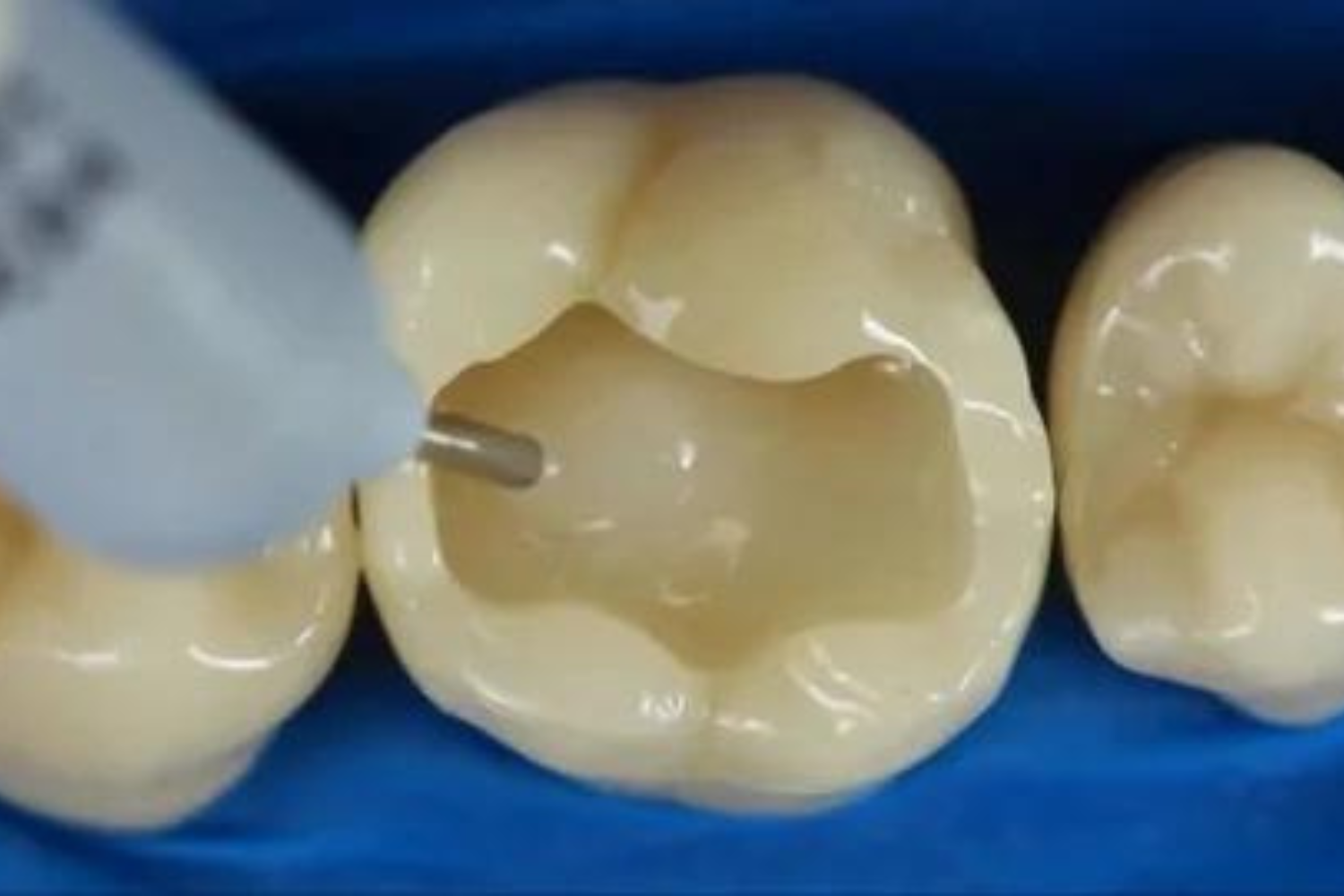
Comprehensive Evaluation: The process begins with an evaluation of your dental health. The dentist examines your teeth and discusses any issues, such as cavities, chips, or cracks that may require composite restoration.
Discussion of Goals: You will discuss your aesthetic and functional goals for the restoration. This includes deciding on the desired outcome in terms of tooth color, shape, and overall appearance.
Customized Plan: Based on the evaluation, the dentist develops a personalized treatment plan. This plan outlines the type of composite restoration needed (e.g., fillings, bonding), the procedure steps, and any potential costs.
Shade Selection: The dentist helps you select a composite resin shade that matches your natural tooth color to ensure a seamless result.
Local Anesthesia: If the restoration involves decay or extensive damage, local anesthesia is administered to numb the area and ensure comfort during the procedure.
Cleaning and Preparation: The affected tooth is cleaned and prepared. If a cavity is present, it is removed using a dental drill or laser. The tooth is then cleaned to remove debris and bacteria.
Etching: The surface of the tooth is etched with a mild acidic solution to create a rough texture. This helps the composite resin bond securely to the tooth.
Bonding Agent: A bonding agent is applied to the tooth to further enhance adhesion between the tooth surface and the composite resin.
Composite Application: The composite resin is applied in layers to the prepared tooth. The dentist carefully shapes and molds the resin to match the natural contours of the tooth. Each layer is hardened using a curing light before the next layer is applied.
Shaping: Once the composite resin is applied and hardened, the dentist shapes and contours it to ensure it fits comfortably with your bite and looks natural.
Polishing: The final restoration is polished to a smooth finish, mimicking the appearance of natural tooth enamel and improving the overall aesthetic.
Bite Check: The dentist checks your bite to ensure the restoration does not interfere with your normal chewing and that there are no high spots.
Care Instructions: You receive detailed instructions on how to care for your composite restoration. This includes maintaining good oral hygiene and avoiding foods or habits that could damage the restoration.
Regular Check-Ups: Follow-up visits are scheduled to monitor the condition of the composite restoration and your overall oral health.
Maintenance Tips: The dentist provides advice on how to prolong the life of your composite restoration, including tips on avoiding excessive force and maintaining regular dental cleanings.
Aesthetic Improvement: Composite resin blends seamlessly with natural teeth, enhancing the appearance of damaged or decayed teeth.
Durability: Composite restorations are strong and can withstand normal biting forces, making them a durable option for restoring tooth structure.
Minimally Invasive: The procedure is less invasive compared to other restorative options, preserving more of the natural tooth structure.
Versatility: Composite restorations can be used for various purposes, including fillings, bonding, and reshaping teeth.
At First Care Dental Clinic and Implant Center, dental composite restoration is performed with precision and care, ensuring that your teeth are restored to their natural function and appearance, enhancing both your dental health and smile.
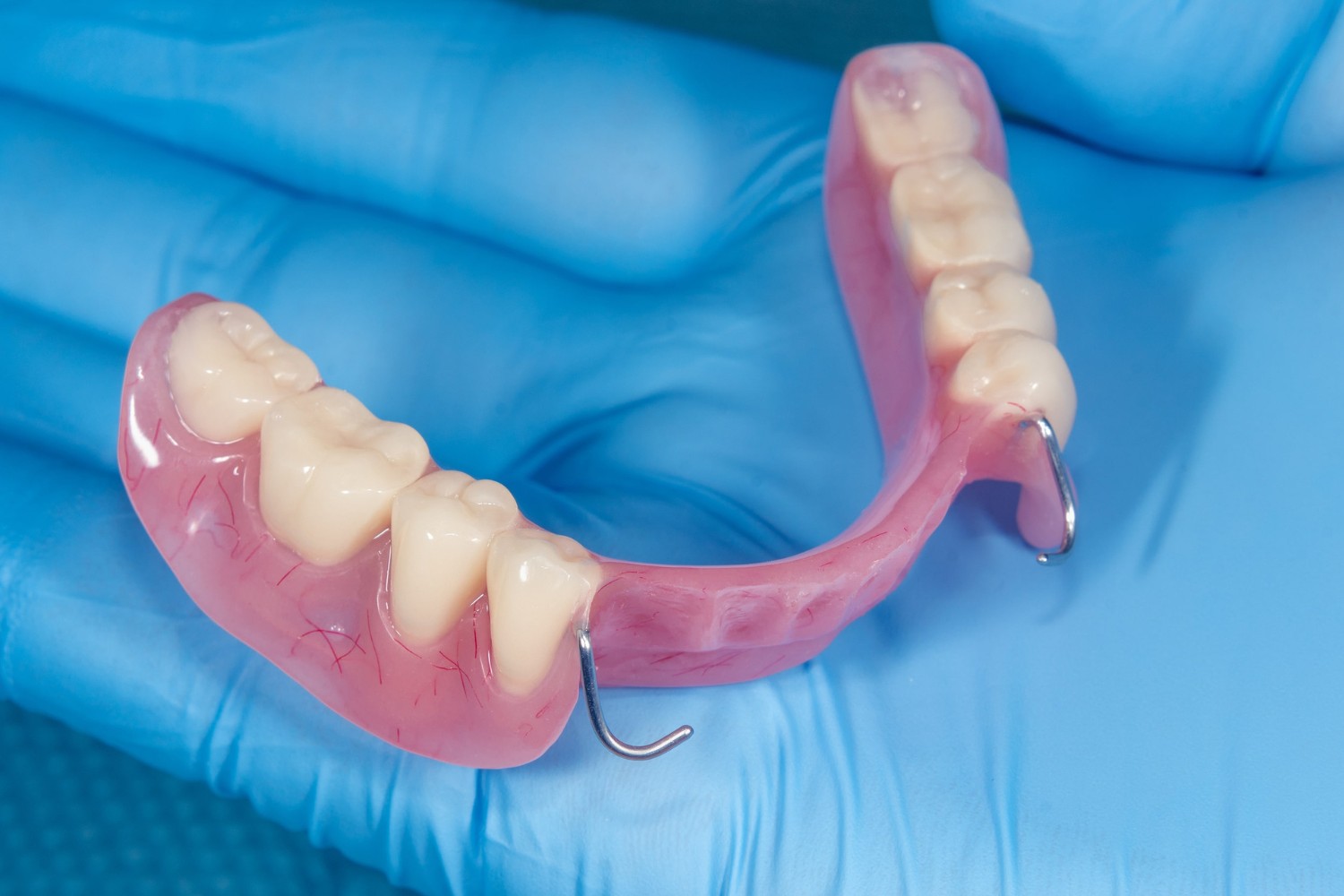

Comprehensive Examination: The dentist begins with a thorough evaluation of your oral health, including your gums, remaining teeth (if any), and jawbone structure. This helps determine whether partial or complete dentures are needed.
Discussion: You’ll discuss your expectations, lifestyle needs, and any concerns you may have about wearing dentures. The dentist will explain the differences between partial and complete dentures and recommend the best option for your situation.
Impressions: The dentist takes detailed impressions of your gums and any remaining teeth. These impressions are crucial for creating a precise fit for your dentures.
Bite Registration: The dentist may also take measurements of how your jaws align when you bite. This ensures that your dentures will fit comfortably and function properly when you chew and speak.
Selection of Tooth Shade and Shape: For a natural look, the dentist will help you choose the shade and shape of the teeth for your dentures, matching them as closely as possible to any remaining teeth or your natural tooth color.
Custom Design: The impressions and measurements are sent to a dental laboratory, where your dentures are custom-made. For partial dentures, the design includes metal or acrylic frameworks that anchor to your existing teeth. Complete dentures are designed to fit snugly over your gums.
Material Selection: The dentures are typically made from acrylic, porcelain, or a combination of materials, ensuring durability and a natural appearance.
Initial Fitting: Once your dentures are ready, you return to the clinic for an initial fitting. The dentist places the dentures in your mouth and checks for fit, comfort, and appearance.
Trial Period: You may be asked to wear the dentures for a short period to get used to them. During this time, you might experience some discomfort or difficulty speaking and eating, which is normal as you adjust.
Adjustments: After the trial period, you return to the clinic for any necessary adjustments. The dentist may need to trim or reshape parts of the dentures to eliminate sore spots and ensure a perfect fit.
Permanent Fitting: After all adjustments are made, the dentures are permanently fitted. The dentist ensures that they are comfortable, functional, and look natural.
Instructions: You’ll receive detailed instructions on how to insert, remove, and care for your dentures, including cleaning tips and what to expect as you adapt to wearing them.
Regular Check-Ups: The dentist schedules follow-up visits to monitor your progress and ensure the dentures continue to fit well. Over time, as your gums and bone structure change, you may need further adjustments.
Long-Term Maintenance: The dentist will advise on when to consider relining or replacing your dentures, typically every 5-10 years, depending on wear and fit.
Improved Function: Dentures restore your ability to chew and speak properly, improving your overall quality of life.
Enhanced Appearance: They provide a natural-looking smile, filling in gaps from missing teeth and supporting facial muscles to prevent a sagging appearance.
Boosted Confidence: Dentures can greatly enhance your self-esteem, allowing you to smile and interact socially without worry.
Custom Fit: Each set of dentures is customized for a comfortable and precise fit, ensuring they stay securely in place.
At First Care Dental Clinic and Implant Center, partial and complete dentures are crafted with precision to restore both the function and aesthetics of your smile, ensuring a comfortable fit and natural appearance.

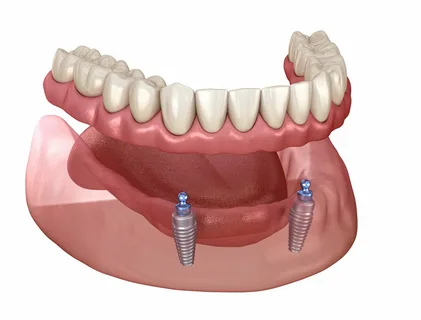
Comprehensive Examination: The process begins with a thorough examination of your oral health, including the condition of your gums, jawbone, and any remaining teeth. The dentist may take X-rays or CT scans to assess bone density and determine the optimal placement for the implants.
Discussion of Needs: You will discuss your goals, concerns, and expectations for implant-supported dentures. The dentist will explain the benefits of this treatment and how it differs from traditional dentures.
Customized Treatment Plan: Based on the assessment, the dentist develops a personalized treatment plan. This includes the number of implants required, their placement, and the type of dentures (fixed or removable) that will be supported by the implants.
Patient Education: The dentist will walk you through the entire process, including what to expect during surgery, the timeline for the procedure, and the associated costs.
Pre-Surgery Preparation: Before surgery, any necessary pre-treatment procedures, such as tooth extractions or bone grafting (if needed), are completed. The dentist will also provide pre-surgery instructions, such as fasting or adjusting medications.
Implant Surgery: The procedure begins with the placement of the dental implants, which are small titanium posts that act as artificial tooth roots. The implants are surgically inserted into the jawbone at predetermined locations. Depending on the number of implants and your oral health, this may be done under local anesthesia, sedation, or general anesthesia. Healing Process (Osseointegration): After the implants are placed, a healing period of several months follows, during which the implants fuse with the jawbone in a process called osseointegration. This creates a stable foundation for the dentures. During this period, you may wear temporary dentures.
Placing Abutments: Once the implants have fully integrated with the bone, abutments (small connectors) are attached to the implants. These abutments will support the dentures. This step may require a minor surgical procedure to expose the implants.
Healing Period: After the abutments are placed, there is typically a short healing period to allow the gums to heal around the abutments.
Impressions: Impressions of your mouth are taken to create a model for the custom dentures. This ensures that the dentures will fit precisely over the abutments and align properly with your bite.
Custom Fabrication: The impressions are sent to a dental lab where your implant-supported dentures are crafted. These dentures are designed to securely attach to the abutments, providing stability and a natural appearance.
Initial Fitting: Once the dentures are ready, you return to the clinic for an initial fitting. The dentist attaches the dentures to the abutments and checks for fit, comfort, and function. Any necessary adjustments are made to ensure a snug fit and proper bite alignment.
Trial Period: You may wear the dentures for a short period to get accustomed to them. During this time, the dentist may make further adjustments to improve comfort and functionality.
Permanent Attachment: Once all adjustments are made, the dentures are permanently attached to the abutments. Depending on the type of implant-supported dentures, they may be removable for cleaning or permanently fixed in place.
Care Instructions: The dentist provides detailed instructions on how to care for your new dentures, including cleaning techniques and tips for maintaining oral hygiene.
Regular Check-Ups: Scheduled follow-up visits are crucial to monitor the health of your implants, gums, and overall oral health. The dentist will check for any issues with the fit or function of the dentures and address them promptly.
Long-Term Maintenance: The dentist will advise on maintaining your dentures and implants, including regular cleanings, adjustments, and potential replacements as needed over time.
Stability: Implant-supported dentures are more stable than traditional dentures, allowing you to eat, speak, and smile with confidence.
Bone Preservation: Implants help preserve the jawbone, preventing the bone loss that typically occurs with traditional dentures.
Natural Appearance: These dentures provide a more natural look and feel, closely mimicking the function and appearance of natural teeth.
Comfort: Implant-supported dentures are custom-fit for comfort, reducing the risk of irritation or sore spots often associated with traditional dentures.
At First Care Dental Clinic and Implant Center, implant-supported dentures are designed to provide a secure, comfortable, and long-lasting solution for replacing missing teeth, enhancing both your oral health and quality of life.
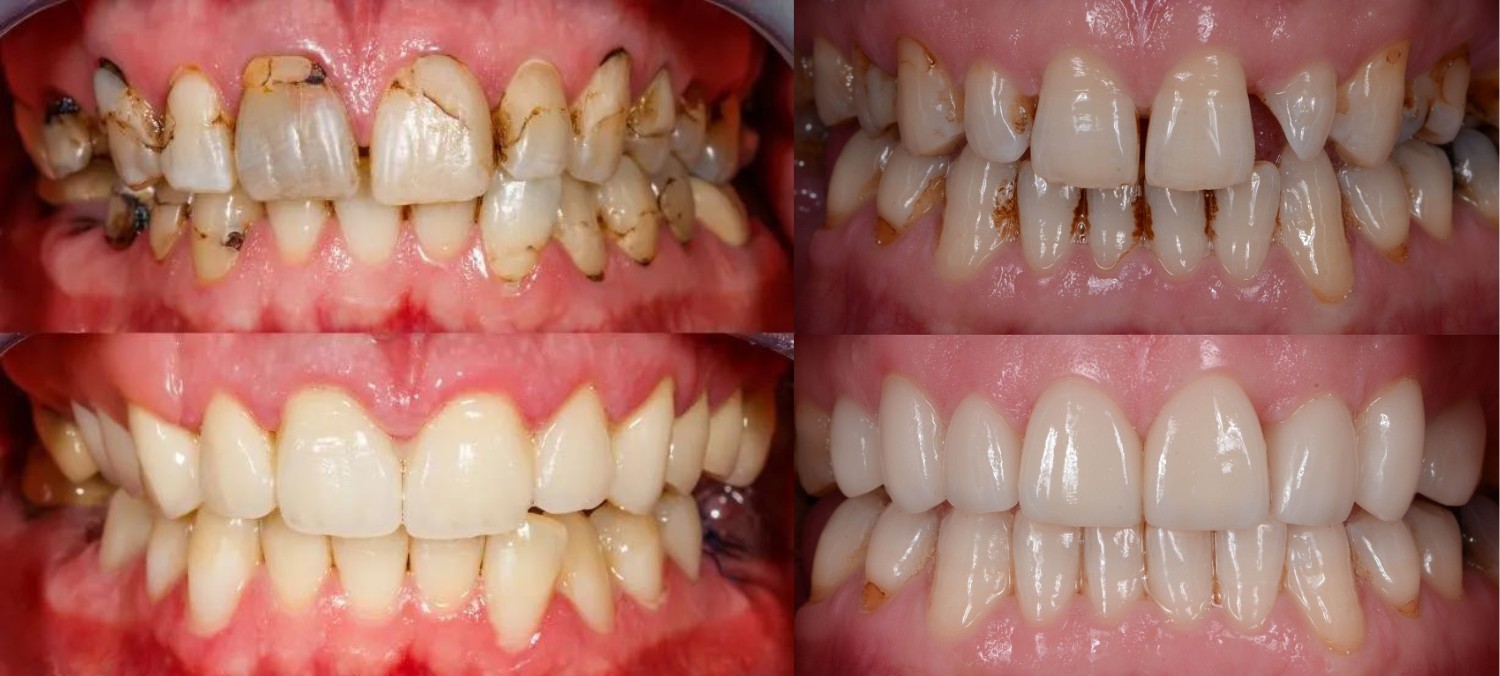
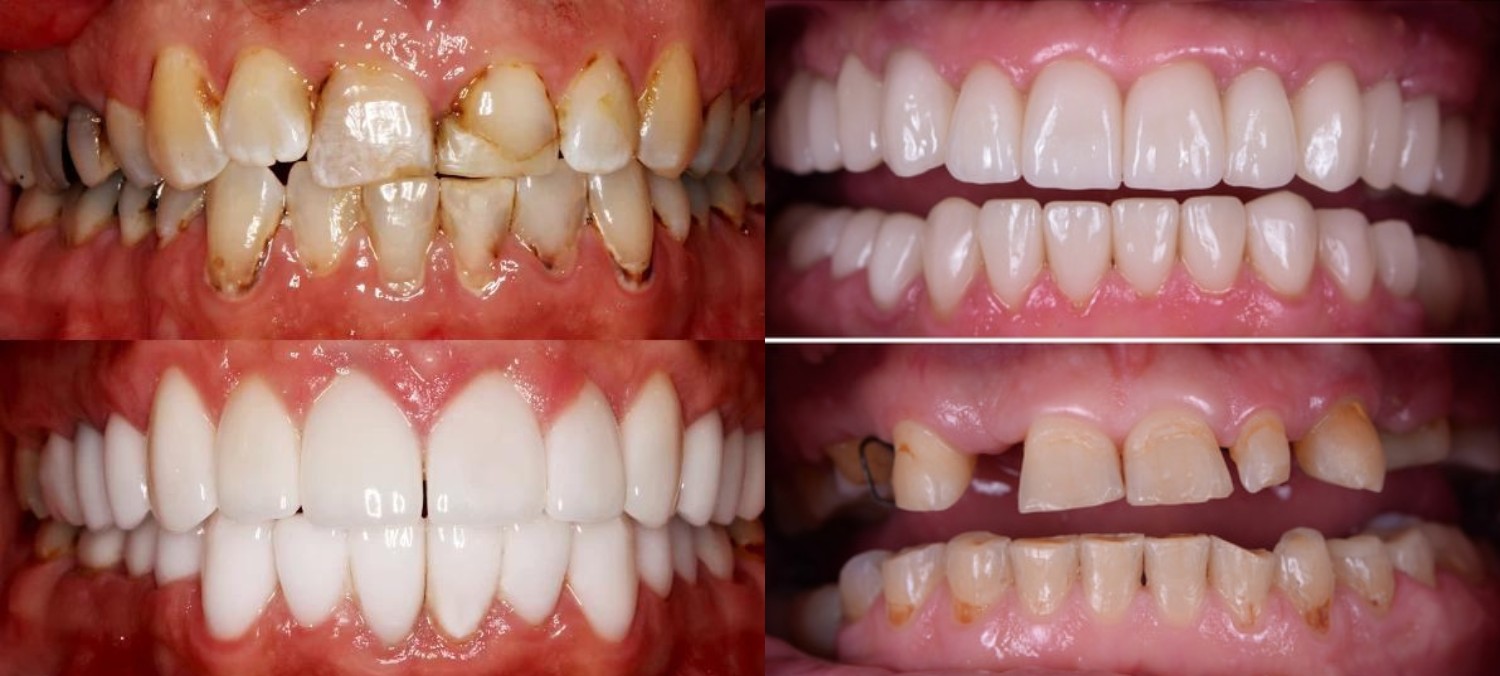
Examination: The dentist thoroughly assesses your teeth, gums, and bite, often using X-rays.
Discussion: You discuss your concerns, such as pain or aesthetics, and set goals for treatment.
Scaling & Root Planing are deep-cleaning procedures which chip off tartar that hardens to the surfaces of your teeth and roots. The treatments help protect your smile and prevent the loss of teeth, gums and bone.
Customized Plan: A detailed plan is created, including procedures like crowns, implants, and orthodontics, with a timeline and costs explained.
Immediate Care: Any urgent issues, like infections or extractions, are treated first to ensure a healthy foundation.
Tooth Restoration: Damaged teeth are repaired with fillings, crowns, or onlays. Missing teeth are replaced with implants or bridges.
Veneers/Crowns: Veneers or crowns improve the look of your teeth.
Teeth Whitening: Whitening may be done for a brighter, more uniform smile.
Alignment: Braces or clear aligners correct misaligned teeth, improving bite and oral health.
Adjustment: The dentist adjusts your bite for comfort, possibly using splints or night guards for protection.
Fine-Tuning: Final tweaks ensure your new teeth fit well and function properly.
Care Instructions: You receive guidance on maintaining your new smile, including hygiene tips.
Follow-Ups: Regular check-ups help monitor and maintain your results.
Function Restored: You can chew and speak comfortably.
Enhanced Appearance: Your smile looks natural and attractive.
Oral Health Improved: All underlying issues are addressed, preventing future problems.
Boosted Confidence: A restored smile enhances self-esteem.
At First Care Dental Clinic and Implant Center, full mouth rehabilitation provides a comprehensive approach to restoring the function, health, and appearance of your teeth.


Examination: The dentist assesses your gums and teeth, checking for signs of gum disease. X-rays may be taken to evaluate bone loss.
Discussion: The need for scaling and root planing is explained, and a personalized treatment plan is created.
Anesthesia: Local anesthesia may be applied for comfort.
Plaque and Tartar Removal: Specialized tools are used to remove plaque and tartar from the teeth, especially below the gumline.
Smoothing Root Surfaces: The roots of the teeth are smoothed to help gums reattach and reduce pocket depth.
Deep Cleaning: Remaining bacteria and toxins are cleaned from the roots.
Rinse: An antibacterial rinse may be used to reduce infection risk.
Care Instructions: You will receive guidance on managing discomfort and maintaining oral hygiene.
Healing Check: A follow-up visit is scheduled to assess healing and determine if further treatment is needed.
Oral Hygiene: Proper brushing, flossing, and regular dental visits are essential to prevent the recurrence of gum disease.
At First Care Dental Clinic and Implant Center, scaling and root planing are performed to effectively treat gum disease and support long-term oral health.
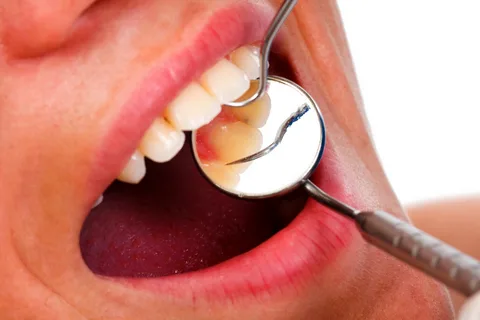
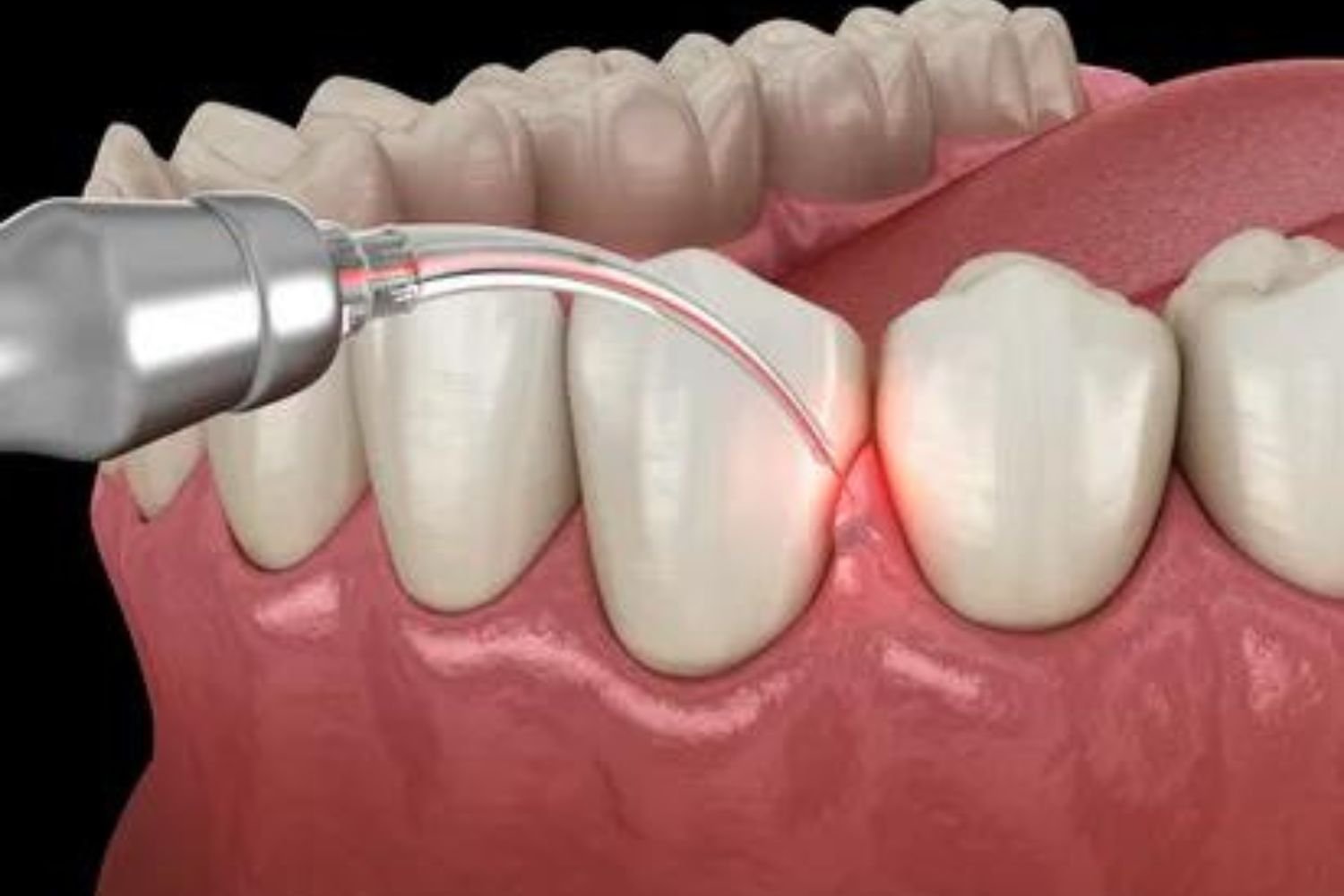
Examination: The dentist assesses gum health, checking for signs of gum disease and measuring gum pockets.
X-rays: X-rays may be taken to evaluate bone health.
Discussion: The dentist explains the findings and discusses treatment options.
Customized Plan: A treatment plan is created based on the severity of gum disease, which may include non-surgical or surgical options.
Patient Education: The dentist explains the procedures, benefits, and potential risks.
Scaling and Root Planing: Deep cleaning to remove plaque and tartar, and smooth roots to help gums reattach to teeth.
Antibiotics: May be prescribed to control infection.
Laser Therapy: Used to remove diseased tissue and promote healing.
Flap Surgery: Lifts gums to clean deep pockets and reposition them around the teeth.
Gum Grafting: Replaces receded gums with tissue grafts.
Bone Grafting: Rebuilds bone lost to gum disease.
Guided Tissue Regeneration: Encourages regrowth of bone and gum tissue.
Rinse and Disinfection: Antibacterial rinses to promote healing.
Pain Management: Instructions for managing discomfort.
Dietary Guidelines: Soft-food diet recommended temporarily.
Oral Hygiene: Guidance on brushing, flossing, and mouthwash use.
Healing Assessment: Follow-up visits to monitor healing and adjust treatment if necessary.
Regular Check-Ups: Ongoing dental visits to maintain gum health.
Periodontal Maintenance: Frequent cleanings for patients with a history of gum disease.
Lifestyle Changes: Recommendations for diet, quitting smoking, and stress management to support gum health.
Prevention of Tooth Loss: Helps prevent the progression of gum disease and tooth loss.
Improved Oral Health: Healthy gums support overall oral health.
Enhanced Appearance: Treatment improves the appearance of gums and teeth.
Reduced Systemic Health Risks: Lowers the risk of related health issues like heart disease.
At First Care Dental Clinic and Implant Center, our gum treatment services focus on restoring and maintaining healthy gums for a strong foundation and better overall oral health.


Examination: The dentist assesses the tooth and surrounding tissues, often using X-rays to determine the condition of the tooth and underlying bone.
Discussion: The dentist explains the need for extraction and discusses possible alternatives or future tooth replacement options.
Personalized Plan: A treatment plan is created, considering factors like anesthesia options and post-extraction care.
Pre-Procedure Instructions: Patients receive instructions to follow before the extraction, especially if sedation is involved.
Local Anesthesia: The area around the tooth is numbed to ensure comfort during the procedure. Sedation options may be provided for anxious patients or complex extractions.
Preparation: The dentist ensures the area is fully numb and ready for the procedure.
Simple Extraction: For fully erupted teeth, the dentist loosens and removes the tooth using forceps.
Surgical Extraction: For impacted or broken teeth, a small incision is made in the gum, and the tooth may be sectioned for easier removal.
Stitches: If needed, stitches are placed to aid healing.
Gauze Placement: Gauze is placed to control bleeding, and patients are advised to bite down gently to form a blood clot.
Pain Management: Instructions for managing pain and swelling are provided, along with advice on using ice packs and medication.
Aftercare Instructions: Patients receive guidelines on diet, oral hygiene, and activities to avoid, like using straws or smoking.
Monitoring: The dentist monitors healing and advises on avoiding dry socket and other complications.
Diet: A soft diet is recommended initially to protect the extraction site.
Oral Hygiene: Guidance is provided on maintaining oral hygiene without disturbing the healing process.
Replacement Options: The dentist discusses options like implants or bridges if tooth replacement is necessary.
Regular Check-Ups: Continued visits ensure proper healing and overall oral health.
Pain Relief: Extraction of a damaged or infected tooth alleviates pain.
Prevention: Removing problematic teeth, like impacted wisdom teeth, prevents future complications.
Oral Health: Extracting irreparable teeth can improve overall oral hygiene.
At First Care Dental Clinic and Implant Center, extractions are handled with care and precision to ensure a smooth procedure and quick recovery.


Child-Friendly Environment: The clinic offers a welcoming, child-friendly atmosphere to help kids feel at ease.
Initial Assessment: The dentist examines the childs teeth and gums, often using X-rays, and discusses any dental history or habits with the parents.
Building Trust: The dentist engages with the child to explain the tools and procedures, making them feel comfortable.
Dental Cleaning: A gentle cleaning removes plaque and tartar to prevent cavities.
Fluoride and Sealants: Fluoride treatments and sealants are applied to strengthen teeth and protect against decay.
Oral Hygiene Education: The dentist teaches the child and parents proper brushing, flossing, and dietary habits to maintain healthy teeth.
Growth Monitoring: Regular check-ups monitor tooth and jaw development, identifying any potential issues early.
Cavity Treatment: If cavities are found, they are treated with fillings, ensuring the process is as comfortable as possible.
Orthodontic Evaluation: Around age 7, the dentist assesses whether the child may need braces in the future.
Positive Reinforcement: The dentist uses praise and rewards to create a positive experience.
Behavioral Techniques: Techniques like “tell-show-do” help reduce anxiety by explaining and demonstrating procedures before performing them.
Parental Support: Parents are encouraged to be involved, providing comfort and support to their child.
Prompt Treatment: The clinic provides quick, effective care for dental emergencies, such as knocked-out or chipped teeth.
Pain Management: Focus is on minimizing pain and ensuring the child feels secure during emergency treatments.
Regular Check-Ups: Routine visits every six months reinforce good habits and monitor dental health.
Habit Counseling: The dentist advises on managing habits like thumb-sucking that can affect dental development.
Dietary Advice: Ongoing guidance on a diet that supports dental health is provided.
Smooth Transition: As the child grows, the dentist helps transition them to general dentistry.
Teen Education: Older children receive advice on issues like smoking, oral piercings, and sports mouthguards.
Prevention: Early care helps prevent cavities and other dental issues.
Positive Experience: Creating a positive dental experience reduces anxiety and encourages lifelong oral health.
Customized Care: Each child receives care tailored to their needs, ensuring healthy development.
At First Care Dental Clinic and Implant Center, our pediatric dentistry services ensure that children receive comprehensive, compassionate care for a lifetime of healthy smiles.

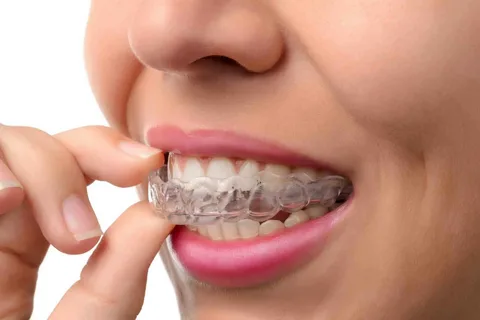
Examination: The dentist assesses your teeth, bite, and jaw alignment, using X-rays and impressions if needed.
Goal Setting: Discuss your concerns, like crooked teeth or bite issues, and outline the desired outcome.
Customized Plan: Based on the assessment, a personalized treatment plan is created, whether its braces, clear aligners, or other appliances.
Explanation: The dentist explains the treatment process, duration, and costs.
Pre-Treatment Care: Any necessary procedures, like extractions, are done before starting.
Hygiene Instructions: You receive tips on maintaining oral hygiene with braces or aligners.
Braces/Aligners: Braces or clear aligners are placed to start moving your teeth into the correct position.
Adjustment Tips: The dentist provides advice on managing discomfort and adjusting to the new appliances.
Routine Visits: Regular appointments are scheduled to adjust braces or provide new aligners as your teeth shift.
Progress Monitoring: The dentist ensures your treatment is on track and makes necessary adjustments.
Removal: Once your teeth are aligned, braces are removed, or aligner treatment is completed.
Final Check: A last evaluation ensures your teeth are correctly positioned.
Retainer Use: A retainer is provided to maintain your new smile, with instructions on how to wear and care for it.
Regular Check-Ups: Periodic visits help monitor the stability of your results.
Maintenance Advice: Tips on keeping your teeth aligned and maintaining oral health.
Improved Smile: Straight teeth enhance your appearance and boost confidence.
Better Oral Health: Easier cleaning reduces the risk of decay and gum disease.
Functional Improvement: Proper alignment improves chewing and speaking.
At First Care Dental Clinic and Implant Center, orthodontic treatment is customized to help you achieve a straight, healthy smile.


Contact: In a dental emergency, call the clinic immediately. Our staff will assess the situation over the phone and provide advice on managing the issue until you arrive.
Urgent Appointment: We prioritize emergency cases and often schedule same-day appointments to ensure quick care.
Quick Check-In: Upon arrival, you'll be promptly checked in and taken to a treatment room to minimize waiting.
Triage: A dental professional performs a quick initial assessment to prioritize the treatment process.
Examination: The dentist conducts a thorough examination, including X-rays if needed, to diagnose the problem.
Diagnosis: The dentist will clearly explain the issue, whether its a toothache, broken tooth, abscess, or another emergency.
Pain Management: Immediate pain relief is provided through anesthesia, painkillers, or other techniques.
Stabilization: The dentist will stabilize any severe conditions, such as reimplanting a knocked-out tooth or draining an abscess.
Toothache: The dentist may perform a root canal or other procedures to relieve pain.
Broken Tooth: Treatment options include smoothing rough edges, applying bonding material, or preparing for a crown.
Knocked-Out Tooth: If possible, the tooth is reimplanted and stabilized with a splint.
Abscess: The dentist drains the infection and prescribes antibiotics.
Instructions: You will receive detailed aftercare instructions on managing pain and maintaining oral hygiene.
Medications: If needed, prescriptions for antibiotics or pain relievers will be provided.
Follow-Up Appointment: A follow-up visit is scheduled to monitor healing and complete any necessary restorative work.
Preventive Advice: The dentist provides guidance on preventing future emergencies and handling them if they occur.
Immediate Relief: Quick treatment to alleviate pain and prevent complications.
Restored Function: Emergency care restores the function and appearance of your teeth.
First Care Dental Clinic and Implant Center is dedicated to providing prompt, effective emergency dental care to ensure the best possible outcomes.